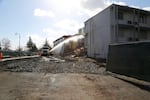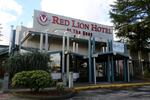
Construction workers tear down a wall of the former Red Lion Hotel Vancouver at the Quay. The Port of Vancouver is planning to replace it with a new hotel and possibly a public market as they work with the city to redevelop the waterfront.
Molly Solomon / OPB
Just under the Interstate 5 bridge on the Washington side of the Columbia river, clouds of dust from debris rise above the former Red Lion Hotel Vancouver at the Quay. Two giant excavators are hard at work tearing down what remains of the local landmark.
The hotel itself has only been here since the 1970’s, but almost everybody in town has a memory of it, including Abbi Russell, communications manager for the Port of Vancouver.
“I have a family member that has a business that used to have Christmas parties here. My husband and I looked at it when we were planning our wedding. My best friend waited tables here in high school,” said Russell as she snapped photos on the hotel’s demolition day. “We all have some kind of connection.”

The former Red Lion Hotel Vancouver at the Quay was located just west of the Interstate 5 bridge. The hotel was torn down in March 2017 to make way for new development on the city's waterfront.
Molly Solomon / OPB
The city's waterfront is just a couple minutes from Esther Short Park and the heart of downtown Vancouver. But the two areas could not be more different. Large swaths of land along the water are still largely industrial or completely vacant. New plans to transform the space could fulfill a long-delayed dream to revitalize the waterfront. The city is hoping the new development will draw tourists and new residents to the growing southwest Washington region.
“It’s going to be a destination both for tourists and businesses alike, as well as residents of the community,” said John McDonagh, the president and CEO of the Greater Vancouver Chamber of Commerce. “They’re going to have access to the riverfront along there in a way that they haven’t had in decades.”
The land slated for development is an area called Terminal 1, a piece of property that the Port has owned since 1926. The building was originally a warehouse that moved goods made in the Pacific Northwest. Everything from lumber and wood products to grains and prunes were exported from the docks and shipped across the country.
“What we had essentially as the front door to the state of Washington, to Clark County, and the city of Vancouver, was an industrial face,” said McDonagh.
McDonagh believes the waterfront makeover represents a shift toward a younger and cooler Vancouver. Just as Portland revitalized formerly industrial neighborhoods, like the South Waterfront and the Pearl District, Vancouver is hoping to capitalize on its prime real estate on the Columbia River.

Big changes are on the horizon for the Vancouver waterfront. Plans by Gramor Development include new restaurants and bars, a waterfront pier, and more than 3,000 new residential units.
Courtesy of Gramor Development
Plans for the Port property call for a new hotel, and possibly a public market space. Down the road, the city of Vancouver has already broken ground on 32 acres of waterfront land. They’re working with Gramor Development on the $1.5 billion project. New restaurants and bars, a waterfront pier, and more than 3,000 new residential units are in the works. McDonagh says all of this, combined with the recent renaissance downtown, is changing Vancouver’s sense of place.
“Place gets defined by those restaurants with a cool vibe, or taprooms, or brewpubs. And I think Vancouver is aware of that,” he said. “And with the influx of young millennials looking for that place, I think the marketplace is responding.”
No Longer 'Little Old Vancouver':
For decades, Vancouver lived in the shadow of its neighbor across the river, Portland.

A view of the Port of Vancouver from the I-5 bridge in 1968. The area along the waterfront was largely industrial but is now gearing up for commercial development along the river.
Courtesy fo the Port of Vancouver
“Vancouver as a community had an inferiority complex – 'Oh well, we’re just little old Vancouver,'” said downtown resident Pat Jollata. “That’s changing now.”
Jollata, a former Vancouver city councilwoman for two decades, says the city has grown a lot since she and her husband moved here in 1982. The downtown renaissance has brought hip restaurants and bars to her neighborhood. She thinks the new waterfront will only improve the city’s identity and help attract people to the Washington side of the river.
“It’s a great transition and people are really drawn to the water,” Jollata said. “And the younger people want to live in a downtown. There is a feeling of being where everything is going on.”
But she says, as a historian, it can sometimes be difficult to see familiar places like the Red Lion come down.
“You always hate to see things go away,” she said. “But I know that what’s going to come will be better than what was there.”